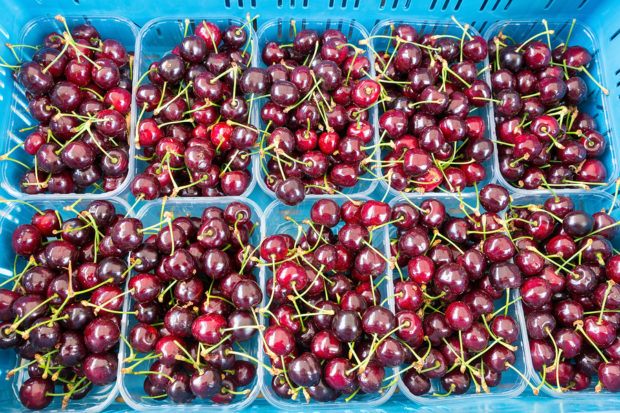February’s record warmth across the U.S. means several weeks of worry for fruit growers in the Midwest and Northeast as trees flower early, leaving them vulnerable to a hard freeze that could sweep in and kill them all.
Spring-like temperatures have come early to the eastern U.S., restricting maple syrup sap harvests and waking up apple, cherry and peach trees from Michigan to New Jersey and New York.
But there’s still a lot of cold air in Canada and northern New England lingering not far from many orchards. Long-term averages show flower-destroying freezing temperatures can still strike from late April to mid-May in most areas. And without the flowers, the trees bear no fruit.
“Fruit growers are afraid the crops are developing too early and will get hit with a freeze,” said Mark Longstroth, extension fruit educator at Michigan State University in Paw Paw. “Everyone would be happy if we had some cooler temperatures to slow down development.”
As of Wednesday, 6,096 new daily high temperature records were set over the last 30 days across the U.S., according to the National Centers for Environmental Information in Asheville, North Carolina. In addition, there were 5,174 record warm low temperatures as well.
In stark contrast, over the same period, just 350 cold records were set.
Records Tumble
All-time highs for February were set in Boston, Milwaukee, Columbus, Ohio, and Binghamton, New York, where readings reached into the 70s Fahrenheit, said Tom Di Liberto, a meteorologist with the U.S. Climate Prediction Center in College Park, Maryland.
“The records that were broken were not just daily records, but monthly records,” Di Liberto said. “Burlington, Vermont broke the record twice in 48 hours, breaking it the second time by 9 degrees. A 70-degree day in Vermont is quite unusual.”
Burlington is 45 miles (72 kilometers) south of the Canadian border.
The warmth had a number of sources. One is that sea-surface temperatures in the western Atlantic and Gulf of Mexico are higher than normal. There were also more winds from the south to push the heat north. February temperatures in the U.S. have risen by 0.3 degrees per decade since 1895, Di Liberto said.
Not all of North America has seen an early start to spring-like conditions.
Apples, Cherries
“There is still feet of snow on the ground in northern New England and a lot of cold air up in Canada,” New Jersey State Climatologist David Robinson said. “All you need is for that to break through for just a night or two. You are ruined for the season.”
A passing cold front could grab some of that freezing air and pump it south, said David Streit, co-founder of Commodity Weather Group LLC in Bethesda, Maryland.
Buds on fruit trees have started to swell, the first stage in growth and about two weeks ahead of schedule in Michigan, said Longstroth. The buds are pretty tough, but if temperatures stay warm the trees will start to flower.
Once they begin to flower, any temperatures below 28 degrees (-2 Celsius) will damage this year’s apple and cherry harvest potential, he said.
In New York, the second-largest U.S. apple producer, things are already getting tricky. Through Tuesday, the average monthly temperature in Syracuse was 7 degrees above normal and the city reached a record 71 degrees Fahrenheit on Feb. 25, the National Weather Service said.
“If we were to get an extremely cold temperature, even for just 24 hours, that could kill the flower buds,” said Karl Niklas, professor of plant biology at Cornell University in Ithaca, New York.
Long-Term Pattern
Last year, an early April warm-up was followed by zero-degree temperatures a few weeks later, destroying apple blossoms in some areas, Niklas said. A similar situation occurred in 2012 when an unusually warm March brought out flowers early, only to see them quashed by freezing temperatures in April, Di Liberto of the Prediction Center said.
“You cannot rule those things out,” Di Liberto said.
The one thing that might bring some solace is that with the longer-term pattern trending warm, there’s a chance it will continue, Commodity Weather’s Streit said. The forecast through March 15 calls for temperatures to be 5 to 8 degrees above normal across most of the eastern U.S. and Canada, according to his company.
“I think the vast majority of the models are warmer, most of the cold for us tends to fall out over the Pacific Northwest,” Streit said. “You are up against this overall pattern tending to be above normal.”





















 Surge of Supercharged Hurricanes Prompt Call for Cat 6 Classification
Surge of Supercharged Hurricanes Prompt Call for Cat 6 Classification  Executives on the Move at Liberty Mutual, Cowbell, W. R. Berkley
Executives on the Move at Liberty Mutual, Cowbell, W. R. Berkley  Five AI Trends Reshaping Insurance in 2026
Five AI Trends Reshaping Insurance in 2026 






